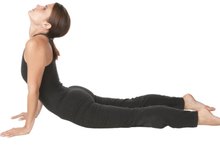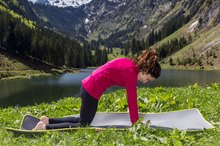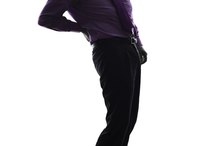Yoga Spine Alignment
According to Dr. Karen Erickson, a spokesperson for the American Chiropractic Association, two main components of maintaining proper spinal alignment are balance and flexibility. Yoga focuses a great deal of attention to developing both balance and flexibility. Improper spinal alignment can cause back pain and decrease range of motion in the spine.
Yoga postures focus on elongating the spine and rediscovering the spine's range of motion. Practicing a few yoga stretches after work can help straighten and strengthen your spine.
Seated Twist
The spine moves forwards and backwards, but also twists from side to side. Yoga twists allow you to lubricate the spine and increase your twisting range of motion. To perform a seated spinal twist, sit in a cross-legged, comfortable position. If you find it difficult to sit comfortably in this position, sit on a block or a few pillows. You can also twist while seated in a chair.
Lengthen the spine and twist the torso to the right.
With each inhale, lengthen the spine and with each exhale, move slightly deeper into the twist. Return back to center and repeat on the opposite side.
- The spine moves forwards and backwards, but also twists from side to side.
- If you find it difficult to sit comfortably in this position, sit on a block or a few pillows.
Bridge Pose
Uterus-Strengthening Yoga Postures
Learn More
Bridge pose strengthens the back and aligns the cervical vertebrae in the neck. Start by lying on your back. Bend your knees and place the soles of your feet flat onto the floor. Press the tailbone into the floor. Bring your arms down by your sides.
Press the feet into the floor as you lift the hips up towards the sky. The lower and middle back should be completely off the floor, leaving only the upper thoracic, cervical spine and head in contact with the floor. Lower the back and hips back down to the floor one vertebrae at a time.
- Bridge pose strengthens the back and aligns the cervical vertebrae in the neck.
- Bend your knees and place the soles of your feet flat onto the floor.
Child's Pose
Use child's pose to re-align the spine. Sit back onto your heels with the tops of your feet flat on the floor. Lower the upper body, touching the forehead to the floor. Extend the arms out in front in you, palms facing down. Child's pose is a resting pose but may not be easily accessible when you first start yoga or if you have tight back or hip muscles.
To modify child's pose try resting the forehead on a block or pillow. Also, if your hips do not touch your heels easily, place folded blankets, pillows or towels in between the buttocks and the heels.
- Use child's pose to re-align the spine.
- To modify child's pose try resting the forehead on a block or pillow.
Corpse Pose
Physical Therapy Exercises for Abdominal Adhesions
Learn More
Corpse pose is the final resting pose in all yoga classes. The pose encourages spinal alignment due to the prolonged contact of the spine on the floor. To practice corpse pose, lie flat on your back on a yoga mat. Bring your arms down by your sides and let your palms face the ceiling.
The legs should be spread slightly with your feet rolling outwards. Close your eyes and focus on breathing deeply and evenly.
If you experience pain or discomfort in the lower back area, place a pillow or folded blankets under your knees. Stay in corpse pose for five minutes, and work up to 15 minutes.
- Corpse pose is the final resting pose in all yoga classes.
- If you experience pain or discomfort in the lower back area, place a pillow or folded blankets under your knees.
Related Articles
References
Writer Bio
Martin Booe writes about health, wellness and the blues. His byline has appeared in the Washington Post, the Los Angeles Times and Bon Appetit. He lives in Los Angeles.









